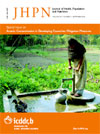
|
The Journal of Health, Population and Nutrition
icddr,b
ISSN: 1606-0997
EISSN: 1606-0997
Vol. 28, No. 1, 2010, pp. 86-94
|
 Bioline Code: hn10011
Bioline Code: hn10011
Full paper language: English
Document type: Research Article
Document available free of charge
|
|
|
The Journal of Health, Population and Nutrition, Vol. 28, No. 1, 2010, pp. 86-94
| en |
Nutritional Status, Dietary Intake, and Relevant Knowledge of Adolescent Girls in Rural Bangladesh
Alam, Nurul; Roy, Swapan Kumar; Ahmed, Tahmeed & Ahmed, A.M. Shamsir
Abstract
This study estimated the levels and differentials in nutritional status and dietary intake and relevant knowledge
of adolescent girls in rural Bangladesh using data from the Baseline Survey 2004 of the National Nutrition
Programme. A stratified two-stage random cluster-sampling was used for selecting 4,993 unmarried
adolescent girls aged 13-18 years in 708 rural clusters. Female interviewers visited girls at home to record
their education, occupation, dietary knowledge, seven-day food-frequency, intake of iron and folic
acid, morbidity, weight, and height. They inquired mothers about age of their daughters and possessions
of durable assets to divide households into asset quintiles. Results revealed that 26% of the girls were thin,
with body mass index (BMI)-for-age <15th percentile), 0.3% obese (BMI-for-age >95th percentile), and 32%
stunted (height-for-age ≤2SD). Risks of being thin and stunted were higher if girls had general morbidity
in the last fortnight and foul-smelling vaginal discharge than their peers. Consumptions of non-staple
good-quality food items in the last week were less frequent and correlated well positively with the household
asset quintile. Girls of the highest asset quintile ate fish/meat 2.1 (55%) days more and egg/milk two
(91%) days more than the girls in the lowest asset quintile. The overall dietary knowledge was low. More
than half could not name the main food sources of energy and protein, and 36% were not aware of the
importance of taking extra nutrients during adolescence for growth spurt. The use of iron supplement was
21% in nutrition-intervention areas compared to 8% in non-intervention areas. Factors associated with the
increased use of iron supplements were related to awareness of the girls about extra nutrients and their access
to mass media and education. Community-based adolescent-friendly health and nutrition education
and services and economic development may improve the overall health and nutritional knowledge and
status of adolescents.
Keywords
Adolescents; Dietary knowledge, Food frequency; Girls; Nutrition; Bangladesh
|
| |
© Copyright 2010 - International Centre For Diarrhoeal Disease Research, Bangladesh
Alternative site location: http://www.jhpn.net
|
|
